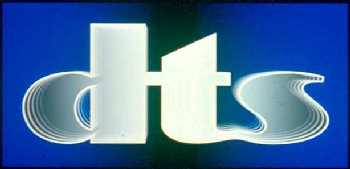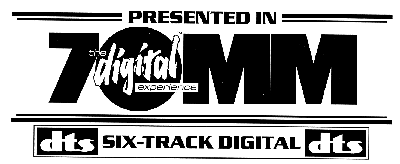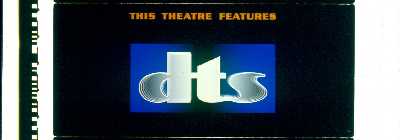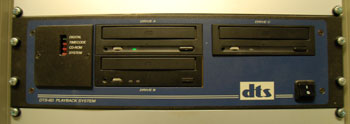What is DTS 70mm? |
This article first appeared in |
||||||||||||||||||||||||||||
| Edited by: Thomas Hauerslev | Issue 46 - September 1996 | ||||||||||||||||||||||||||||
 The DTS 70mm digital sound process for motion pictures is designed to play
in cinemas that are equipped for 70mm projection and 6-track stereo. The DTS 70mm digital sound process for motion pictures is designed to play
in cinemas that are equipped for 70mm projection and 6-track stereo. It is a dual system in that the digital audio data is recorded on CD-ROM discs. A special DTS time code is printed on the 70mm motion picture film (located outside the sprocket holes). The DTS system (with matching movie discs loaded) reads the time code and plays the correct sound for each frame of film projected. Film released in the DTS 70mm format do not have the standard (analogue 6-track sound) magnetic striping, so, analogue sound cannot be used. For fail-safe operation, a second DTS playback unit is required. The DTS time code is written outside the sprocket holes where the 70mm two-track magnetic striping normally resides. This allows the useable picture area to be increased to fill the space used by the inner magnetic stripes. The size of the time code on a DTS 70mm print is huge. At 30 mils wide, it is easily visible to the naked eye. Damage by normal scratches does not affect the readers ability to scan time code. Since the magnetic striping is removed, DTS 70mm prints cannot use analogue sound for backup. Instead, installing a second DTS playback unit is recommended to ensure 100% fail-safe operation. If a malfunction occurs, the main DTS playback unit uses its built-in default circuitry to automatically switch to the second unit. A special time code adapter cable and circuit card connects the two playback units together. The DTS system provides six channels: left, center, right, split surrounds (or mono surround) and subwoofer. The system is completely automatic and fail-safe in operation requiring no action by the projectionist. The system automatically starts and stops, and tracks film breaks and change overs. Transfer into the process can be made from conventionally mixed analogue or digital soundmasters. The projectionist inserts the movie disc(s) into the DTS player unit and threads the film through the DTS 70mm time code reader head. Once the film is started, the DTS system checks the keyed serial number in the time code and on the movie disc(s) to assure the correct sound is played with the picture projected. |
Further in 70mm reading: |
||||||||||||||||||||||||||||
|
|||||||||||||||||||||||||||||
DTS "Special Venue" |
|||||||||||||||||||||||||||||
|
DTS "Special Venue" is a
term used to identify any film format that is not the standard release
format of 35mm 4 perforations per frame. Digital Theater Systems can do:
35mm at special speeds, Super 35, 70mm at special speeds, 16mm, DTS
timecode or SMPTE timecode, 3-D, multi-language and multimedia. The
applications done have been simulation rides, large screen movies, 16mm
films, road shows, 70mm, 3-D rides, documentary or special subject films
and multimedia. The multimedia we have done is the transfer of broadcast quality stereo video to film for theatrical release and laser disc for exhibition (not home use). Customers of DTS "Special Venue" have been IMAX, IWERKS, Warren Miller, NFL, The U.S. Goverment, Showscan, Warner Brothers Theme Parks, Universal Studios and others. Two things are required to make DTS 70mm stock: A special DTS camera and a DTS "special venue" timecode generator. The special camera prints timecode on the outside of sprocket holes on 35mm film. DTS supplies the special camera and we install it at the recording facility free of charge. The recording facility then prints a master track of the DTS timecode on 35mm film negative which is sent to the lab who marries it to the 70mm picture negative. Then, the labs make their DTS 70mm production run. Laboratories currently set up to print DTS 70mm film are DeLuxe, CFI and Technicolor (all in Los Angeles, California, USA) and Technicolor in London, England. Two "special venue" timecode generators are available. One is at DTS (in Los Angeles) and the other is with Max Bell in England. |
|||||||||||||||||||||||||||||
The Industry and DTS 70mm |
|||||||||||||||||||||||||||||
 Unofficial
70mm DTS logo created by Bobby Henderson Unofficial
70mm DTS logo created by Bobby HendersonDigital Theater Systems have been approached by 70mm film fans and restores. This is how DTS got "Vertigo". We are also in final negotiations for a new film currently in production ["Hamlet"]. Based on the fact that we anticipate doing two films in 1997 and in that doing a 70mm film in the DTS 70mm format saves the filmmaker a welcome 20 - 25% savings (because of the absence of magnetic tracks), it has been an overall success. We are currently working with Universal and Castle Rock. We have also done a demo for Lucasfilm. |
|||||||||||||||||||||||||||||
Where To Hear DTS 70mm "Special Venue"? |
|||||||||||||||||||||||||||||
 Here are a few places to look for. San Francisco Pier 39 "San
Francisco The Movie" a 70mm documentary. Here are a few places to look for. San Francisco Pier 39 "San
Francisco The Movie" a 70mm documentary. Warner Brothers Theme Park in Germany a 70mm 3-D motion ride film. NFL "Hall Of Fame" road show. Showscan "Kivi Magic" documentary presented in multi languages (English, French, Japanese, Korean and Chinese) in New Zealand installation. Showscan at the Trocadero in London (laserdisc on big screen). To date 46 DTS "special venue" projects have been completed. Commercial Theatres With DTS 70mm. Currently four theatres have the DTS 70mm installed: The GCC Hollywood Galaxy in Hollywood, USA, The Castro Theatre in San Francisco, USA, The Colosseum in Oslo, Norway and the Pathe Cinemas Cinerama Bellevue in Amsterdam, Holland. Theatres that would like to show "Vertigo" in DTS 70mm should contact their film distributor (Universal Pictures/United International Pictures) and request it. The number of commercial theatres that will need the DTS 70mm hardware is dependent on the quantity of release prints. |
|||||||||||||||||||||||||||||
Hardware Needed |
|||||||||||||||||||||||||||||
|
For theatres already equipped with DTS 35mm system and setup for 70mm
projection, the purchase of a DTS reader and bracket is required. The 70mm
reader can be mounted onto the projector next to the DTS 35mm reader. If
space is not available, an optional breakaway bracket and spacer can be
used so either size reader can mount (one at a time) to the same bracket.
Thumbscrews on the spacer plates allow for easy change between DTS 35mm
and DTS 70mm readers. |
|||||||||||||||||||||||||||||
For DTS 70mm only |
|||||||||||||||||||||||||||||
 A
DTS playback unit, interconnect cables, and a DTS 70mm reader for each
projector is required. A second DTS playback system (minus reader), A
D462-00 adapter cable, and a D582 board are required for 70mm fail-safe
operation. A
DTS playback unit, interconnect cables, and a DTS 70mm reader for each
projector is required. A second DTS playback system (minus reader), A
D462-00 adapter cable, and a D582 board are required for 70mm fail-safe
operation. |
|||||||||||||||||||||||||||||
For DTS 35mm and DTS 70mm combination |
|||||||||||||||||||||||||||||
|
A standard DTS system (includes the 35mm reader and interconnect
cables) and a DTS 70mm reader for each 70mm projector is required. A
second DTS playback system (minus reader), a D462-00 adapter cable, and a
D582 board are required for 70mm fail-safe operation. Systems requiring that the same projector accommodate both the DTS 35mm and the DTS 70mm readers need special brackets, adapters and a spacer plate for each reader. |
|||||||||||||||||||||||||||||
The DTS Processor |
|||||||||||||||||||||||||||||
 The
DTS 6D The
DTS 6DFail Safe: Automatic default to proper optical sound format: SR, A-type, mono and non-sync. Closures provided for automation interface. Compatibility: Compatible with multi-channel systems from UltraStereo, Kintek, Dolby and Smart cinema processors in the analog mode. Compatible with both the UltraStereos DSP-60S digital cinema processor and Cinema Acoustic CA-CA600 digital cinema processor in the digital mode. Size: 51/4 inches high (13,33 cm), 19 inch (48,26 cm) long rack mount, 17 inches deep (43,18 cm) with cords attached. List Price: $5950.00 USD (1996 prices, ed). Includes player, all cables, one reader, plus reader mounting bracket & hardware, and installation manual. Advertizing materials available free of charge to DTS installed theatres. 6-channel configuration: Left, Center, Right, left Surround, Right Surround and Subwoof. All new digital output for the DSP (digital signal processor) cinema processors. Contain three CD- ROM drives that allow for play time up to 5 hours. The third CD-ROM drive can be used for DTS encoded trailers as well as 6-channel non-sync sound. Provides stereo surround and mono surrround outputs at all times without the need for internal switching. Powered output to DTS reader head uses self re- setting circuit brakers instead of fuses. Two projector houses: provides for picture and sound simultaneous change over. Unit is FCC, CEA and UL approved. |
|||||||||||||||||||||||||||||
Offset Adjustment |
|||||||||||||||||||||||||||||
 35mm
DTS Reader 35mm
DTS ReaderFor theatres already equipped with DTS 35mm, readjustment of the DTS playback units offset is required for the sound to play in sync with the 70mm picture projected. Use the same formula as with 35mm film: number of frames (between picture aperture and reader) x 1,25 = offset number. |
|||||||||||||||||||||||||||||
|
Go: back
- top - back issues Updated 21-01-24 |
|||||||||||||||||||||||||||||
